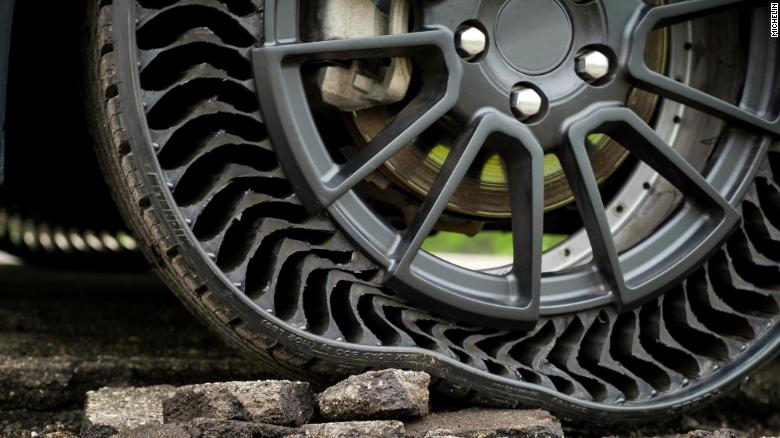(CNN)Michelin has been working with General Motors to develop airless tires that will be sold on a next-generation Chevrolet Bolt electric car, expected to go on sale in the next few years, a Michelin executive said. It could mark the decline of over 130 years of tire tradition but also the end of one of the most annoying aspects of car ownership: keeping air in the tires.
“We want to bring the next generation of the Chevrolet Bolt with airless tires,” Alexis Garcin, president of Michelin North America said in an interview with CNN Business, “and it’s going to happen now in the next three to five years.”
GM has not confirmed that it is working on a new car to be called the Chevrolet Bolt, the same name as the automaker’s current EV, but GM has said it is working on a wide variety of electric vehicles including affordable ones similar to the Bolt in price. Michelin and GM have tested the airless tire on current-generation Bolt cars, though, something the companies have been open about.
It’s ironic that the first airless tire for passenger cars might come from the French tire maker whose famous mascot — Bibendum, more popularly known as the Michelin Man — is made from air-filled tires. The company made its name in the late 1800s with advancements to pneumatic (air-filled) tires for bicycles and was among the first to produce and market them for use on automobiles. In 1899, the first car to set a world speed record using pneumatic tires, a rocket-shaped electric car that went 66 miles an hour, did it on Michelins. The company has gone on to produce pneumatic tires used in other speed record attempts by companies like Bugatti.
The disadvantages of filling tires with pressurized air are obvious. Air is a gas that can leak, and tires are vulnerable to punctures. Tire makers have spent over a century coming up with ways to minimize punctures and keep air inside these circular rubber tubes, but it still happens with some regularity.
Michelin’s airless tire design relies on flexible ribs to provide a sort of spring action, roughly the same way air does in a pneumatic tire. If the tread gets punctured, it makes little difference since the tire doesn’t hold in air. In fact, the sides of the airless tire are completely open.
Of course, there are reasons airless tires haven’t been used on passenger cars in over a century. Air does have its advantages. For one thing, pressurized air allows tires to be customized for specific uses. For instance, a driver taking a four-wheel-drive truck off-road might reduce the air pressure in the tires, which allows the tire to flatten out a bit creating a larger footprint area on loose sand or dirt. The tires can then be re-inflated when the truck goes back to driving on asphalt.

